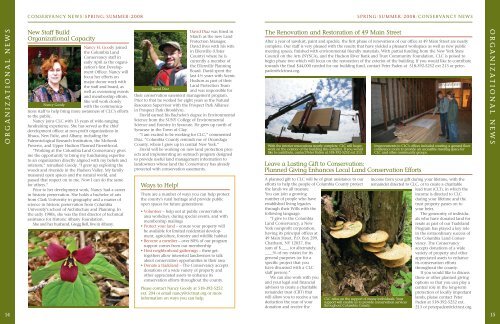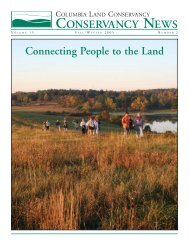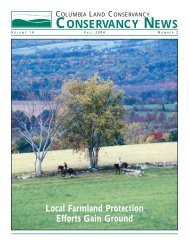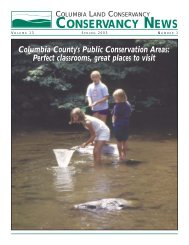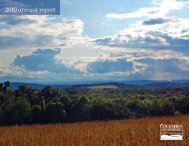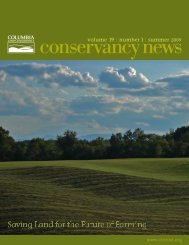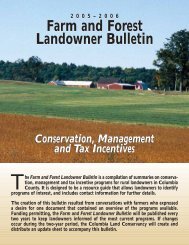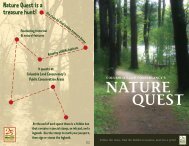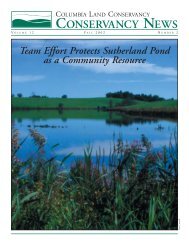Spring 2008 - Columbia Land Conservancy
Spring 2008 - Columbia Land Conservancy
Spring 2008 - Columbia Land Conservancy
Create successful ePaper yourself
Turn your PDF publications into a flip-book with our unique Google optimized e-Paper software.
CONSERVANCY NEWS/SPRING/SUMMER/<strong>2008</strong><br />
SPRING/SUMMER/<strong>2008</strong>/CONSERVANCY NEWS<br />
C O N S E R VA T I O N E A S E M E N T S<br />
What is a<br />
Conservation Easement<br />
A conservation easement is a tool that allows a<br />
landowner to permanently protect his/her land<br />
through a legal agreement, written in the form of<br />
a deed. Through the conservation easement, a<br />
landowner donates the majority, or entirety, of the<br />
property’s development rights to a qualified nonprofit<br />
land trust or governmental entity. There are<br />
six important points to understand about CLC’s<br />
conservation easements:<br />
1) The property is still owned by the easement<br />
donor. The landowner can sell, lease, bequeath,<br />
or mortgage land protected by a conservation easement.<br />
The landowner can still farm or conduct<br />
conservation forestry on the land, in addition to<br />
home-based businesses and rural enterprises<br />
(assuming that zoning allows for this) and is not<br />
required to allow public access.<br />
2) They often entitle landowners to significant state<br />
and federal income tax deductions. For donated<br />
easements, the landowner may be able to deduct the<br />
value of the conservation easement against as much<br />
as 30 percent (and in some cases 50 percent) of their<br />
adjusted gross income for up to six years, beginning<br />
in the year the easement is donated. Pending new<br />
federal rules may allow significantly increased tax<br />
benefits. However, if a landowner protects only<br />
a portion of the property, the deduction may be<br />
substantially reduced (the landowner should discuss<br />
this with his/her financial advisor).<br />
being protected. It should be noted that the more<br />
residential buildings retained under the terms of the<br />
easement, the smaller the landowner’s tax deduction<br />
likely will be.<br />
4) The property stays on the tax rolls. <strong>Land</strong>owners<br />
may work with the town assessor to determine if the<br />
easement warrants a reduction of property taxes.<br />
Many communities in the country are recognizing<br />
that conserved land helps balance open space and<br />
development which, in turn, helps maintain a strong<br />
fiscal base in a municipality.<br />
A conservation easement does not necessarily lead<br />
to lower property taxes in <strong>Columbia</strong> County, and in<br />
most cases it has not done so. However, a landowner<br />
may choose to place some or all of the land under<br />
the Agricultural or Forestry “current use” programs<br />
and receive a property tax reduction as provided<br />
in those programs. A New York State Tax Credit is<br />
available to landowners whose land is restricted by<br />
a conservation easement that provides an annual<br />
refund of 25% of the property taxes paid on that<br />
land, up to $5,000 per year.<br />
5) They are tailored to meet each landowner's individual<br />
vision for his/her land. All landowners who<br />
protect their land with a conservation easement<br />
work closely with the <strong>Conservancy</strong> to develop a plan<br />
that meets their conservation goals and need for<br />
future development. Public access is not required.<br />
However, some landowners elect to establish a<br />
public trail as part of their conservation easement.<br />
This generally increases the potentially available<br />
income tax deduction.<br />
Planning for the Future.<br />
During the past 15 months, CLC<br />
has been engaged in an intensive<br />
strategic planning process. Under<br />
the guidance of Linda London, of<br />
London Associates, six board and<br />
staff work groups have endeavored<br />
to re-focus the work of the<br />
<strong>Conservancy</strong> to better serve the<br />
conservation needs and desires of<br />
the community. Our new five-year<br />
strategic plan was approved by the<br />
Board of Trustees on April 19, <strong>2008</strong><br />
and will be rolled out to the public<br />
by mid-year. The substance of this<br />
plan, however, is already incorporated<br />
into our <strong>2008</strong> work goals.<br />
Conservation Strategy<br />
This year, CLC will be dedicating<br />
significant resources to compiling a<br />
comprehensive natural resource<br />
inventory of the county. The information<br />
gathered will be analyzed<br />
using computer mapping software<br />
known as a geographic information<br />
system (GIS). The results will help us<br />
evaluate and prioritize potential conservation<br />
projects throughout the<br />
county. This information will also<br />
be shared with town and county<br />
boards and organizations. Grants<br />
from the Ellsworth Kelly Foundation<br />
and the <strong>Land</strong> Trust Alliance Partnership<br />
Program will pay for this strategic<br />
conservation plan.<br />
Agricultural Support<br />
Agriculture is vitally important to<br />
the local economy and has been a<br />
defining force in shaping <strong>Columbia</strong><br />
County’s countryside. Working<br />
with local farmers to identify ways<br />
in which the <strong>Conservancy</strong> can help<br />
agriculture thrive is central to our<br />
mission. From securing funding for<br />
farmers through the New York State<br />
Farmland Protection Program<br />
(see page 6) to finding ways to put<br />
fallow land back into production,<br />
CLC sees the value in supporting<br />
agriculture as a means of conserving<br />
our landscapes.<br />
Community Resource<br />
Towns throughout the county are<br />
examining what they can do to<br />
help shape the future of their communities.<br />
In almost every case,<br />
community surveys reflect that<br />
what people like and want to maintain<br />
about their towns is the rural<br />
character, farms, and open spaces.<br />
Our staff is frequently called upon<br />
to share perspectives and insights<br />
on approaches municipalities can<br />
employ to retain the desired land<br />
use patterns. CLC will continue to<br />
promote sound land use planning<br />
and practices that will help communities<br />
guide growth so as to be<br />
compatible with the conservation<br />
of the natural resources the county’s<br />
farms and wildlife depend on.<br />
In response to the community<br />
feedback we received during the<br />
strategic planning process, CLC will<br />
be stepping up its communication<br />
with our members and the general<br />
public. We will be looking for new<br />
opportunities to learn what the<br />
conservation needs of the community<br />
are and to broaden public<br />
awareness of what CLC has to offer.<br />
This is just a brief overview of the<br />
highpoints of CLC’s strategic plan<br />
for the next three years. As the goals<br />
and objectives of this plan are implemented<br />
in the coming months, it is<br />
the feedback we receive from local<br />
leaders in farming, town and county<br />
government, conservation, and our<br />
membership that will guide our<br />
efforts to save the farms, forests,<br />
and landscapes that make <strong>Columbia</strong><br />
County so special.<br />
S T R A T E G I C P L A N U P D A T E<br />
Conservation easements give landowners the ability to create a lasting conservation plan for their land.<br />
3) They do not prohibit all development. A limited<br />
number of residential buildings, including supporting<br />
structures (e.g., recreational buildings, guest<br />
houses, tennis courts, agricultural structures,<br />
garages, storage sheds, swimming pools, etc.) may<br />
be allowed. Future development is located to minimize<br />
any negative impact on the land resources<br />
6) The <strong>Conservancy</strong> staff and Board will maintain<br />
confidentiality. All easement negotiations are confidential<br />
unless the landowner requests that we<br />
inform identified individuals in the community.<br />
The easement becomes public knowledge after it is<br />
completed and filed at the County Clerk’s office.<br />
Support Local Conservation: Become a member.<br />
Conservation in <strong>Columbia</strong> County is at a critical point. CLC has the opportunity to expand its role supporting<br />
the conservation vision of the community. With the support of our members, we will continue to serve<br />
as a conservation resource for <strong>Columbia</strong> County; hosting 175 free outdoor education programs, providing<br />
access to 3,000 acres of scenic natural areas, and accepting and stewarding conservation easements for private<br />
landowners while implementing exciting new initiatives under our strategic plan. For information on becoming<br />
a member, please contact Marcia Cary at 518-392-5252 ext. 202, or email Marcia@clctrust.org.<br />
8<br />
9


